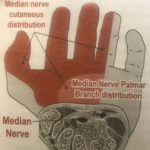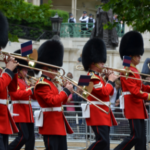De Quervain’s tenosynovitis (DQT) is inflammation of the tendons and tendon sheaths of two thumb muscles. De Quervain’s is also known as ‘new mum’s thumb’ because hormonal fluctuations affecting the tendons, combined with hand positions used to support the weight of a baby, place a strain on the affected muscles.
The involved muscles are abductor pollicis longus (APL), which abducts the thumb, and extensor pollicis brevis (EPB), which extends it.
What causes De Quervain’s?
Repetitive use of the wrist or thumb muscles can result in microtrauma and inflammation. This leads to pain over the thumb.
High levels of the hormone relaxin, which is elevated during and after pregnancy, predispose to De Quervain’s. The purpose of relaxin is to prepare the body for labour – relaxin relaxes the ligaments and tendons, thus making the joints more mobile.
However, when the tendons are more stretchy, they are more likely to become irritated from overuse.
Who gets it?
Overuse of APL and EPL – the muscles involved in DQT – is common, because a range of hand movements requires these two thumb muscles. If you do a lot of the following, you are using these muscles:
- texting & using a smart phone
- picking up a baby
- playing the piano or the guitar
- typing, cashier work
If you have just given birth and are breast-feeding, and have high levels of relaxin, you are more likely to get DQT.
You are also more prone to De Quervain’s if you have rheumatoid arthritis or osteoarthritis.
What are the symptoms of De Quervain’s?
The main symptom is pain along the base of the thumb and into the wrist. The pain is usually be sharp on movement. Some patients report ‘squeaking’ or a ‘locking’ of the thumb.
The thumb pain tends to be better with rest, heat or cold.
How is DQT diagnosed?
A good case history, palpation and muscle testing are usually sufficient. Finkelstein’s test, which places the hand into a position that stretches the abductor pollicis longus and extensor pollicis brevis, is a specific test that is useful.
Imaging is unnecessary.
What are the treatments for De Quervain’s tenosynovitis?
Conventional techniques
If possible, minimise the thumb movements which aggravate the tendons and rest the wrist and thumb. A wrist brace with a thumb spica will immobilise and protect the thumb. Ice can help reduce any local inflammation. Later, you can use heat therapy.
Massage
A massage therapist can do myofascial release of the forearm. However, osteopathy is more appropriate in the treatment of De Quervain’s.
Acupuncture
An acupuncturist may work with the local wrist points LI5, GB34, SJ5, LV8, SP10 and LV3.
Surgery
Surgery is rarely required. Orthopaedic consultants consider it in severe cases where conservative treatments have failed.
Can osteopathy help De Quervain’s tenosynovitis?
As an osteopath who uses AK diagnoses, I will test for, and treat, reactive muscle patterns. These are muscle reflexes where one muscle may inhibit another. I also treat the nerve supply to the thumb muscles and will treat dysfunctions in the forearm and elbow.
I have found that osteopathy is very effective in the treatment of De Quervain’s.
If you have thumb pain that you believe could be due to De Quervain’s, please do not hesitate to get in touch.
To book an Osteopathy appointment in New Malden or in Marylebone, phone 020 8942 3148 or contact Aston Clinic London.
Aston Clinic London is a third-generation complementary health clinic based in New Malden and serves the local areas of Kingston, Wimbledon, Raynes Park, Surbiton, Chessington, Worcester Park, Sutton and other areas of southwest London and Surrey.
Aston Clinic London also offers Osteopathy and Herbal Medicine in Marylebone, Central London.

